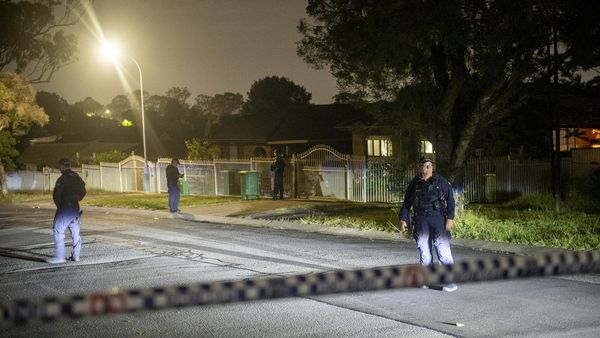
A helicopter swoops over a sun-kissed marina, where young couples stroll along a waterfront promenade, between the masts of sailing boats and the chiselled concrete ziggurats of dashing modern flats. Up above, elevated walkways carry families from their front doorsteps to the futuristic town centre, where a medical facility stands on stilts above a lake, and parades of shops line a network of glistening canals.
It looks like an advertisement for a luxury resort in the south of France, but these were the plans for Thamesmead, the new town drawn up in the 1960s by the architects of the Greater London council for a 650-hectare swathe of Thames estuary marshland. As a promotional film trumpeted at the time, it was to be a place where 60,000 people would live “in environmental conditions unmatched by anything that has existed before”. It would be a world of clean, bright, spacious homes built with modular, factory-made concrete panels, with pedestrian life safely raised above traffic, and the delights of waterside living available to all in this cockney Venice-on-Thames.
“The plans were so revolutionary,” recalled Terry Gooch in 2008, on the 40th anniversary of Thamesmead. “We thought we’d be the start of that revolution.” His family was the first to move in, chauffeur-driven from their cramped flat in Peckham, where they had an outside toilet and no bathroom. They were chosen as the “pioneers”, and ended up being the only residents for some time – living in the middle of a building site, waiting six months for nextdoor neighbours to arrive.
Architects and planners visited from across the globe to marvel at the brave new waterworld, where homes were lifted above the floodplain in long rows of stacked maisonettes exuding groovy 60s style. Thamesmead was showered with accolades, scooping a prestigious gong in 1969 from the Parisian Union Internationale des Architectes, for its “harmonious integration of human values, aesthetic expression and modern techniques”. The film director Stanley Kubrick chose to film A Clockwork Orange here because it embodied of the kind of futuristic, refined, riviera-style setting that would make his scenes of “ultraviolence”, set to classical music, seem even more shocking. He wanted the newest, most forward-looking place, and Thamesmead was it.

But, like most 60s utopias, it didn’t quite work out as planned. The novel construction system led to leaks and damp; the parades of shops never materialised, and the multi-levelled network of streets and bridges became a confusing, crime-friendly labyrinth. Most damagingly of all, the promised Jubilee tube connection to central London didn’t happen, leaving the place cut off, a modernist experiment marooned in the marshes at the ends of the earth.
It had been imagined as a mixed community, with council homes alongside penthouse flats for sale, but it became a place where only the most desperate were funnelled. When Margaret Thatcher abolished the Greater London council (GLC) in 1986, Thamesmead began a steady decline, its ownership and management structures split, its buildings left to moulder. The following phases abandoned the municipal modernism of the 60s altogether, in favour of winding drives and cul-de-sacs of suburban brick homes, the whole place turning its back on the river, as if trying to make the extraordinary setting as ordinary as could be. A “town centre” finally arrived in the 90s, but it took the form of a retail park, with supermarkets stranded in a sea of car parking on the edge of the marsh, a good drive from most residents’ homes. The 00s saw housing association Gallions begin to demolish chunks of the 60s concrete blocks and insert its own lacklustre additions, leaving a forlorn array of brutalist fragments, new-build homes and rubble-strewn wasteland.

It was this inauspicious situation that Peabody, one of the country’s oldest and largest housing associations, took over in 2014. With Crossrail extending a tunnel of supercharged property speculation eastwards out of London to Abbey Wood, just south of Thamesmead, Peabody identified a chance to capitalise on the bucolic riverside setting, now just 25 minutes from the West End, and began drafting plans to double the number of homes here over the next 30 years. This would not just be housing to “ameliorate the condition of the poor and needy of this great metropolis”, as the American banker-philanthropist George Peabody had intended when he established his eponymous trust in London in 1862. Instead, it would be an exercise in “regeneration”, razing swathes of the estate in order to build flats for sale at much higher densities, with 35% classed as affordable – on a scale rarely seen before. As if that’s not enough, Peabody has also begun plotting an £8bn joint venture with Lendlease, cleansers of the Heygate Estate in Elephant and Castle in south London, on a 100-hectare waterfront site next door.
“We found ourselves in the unusual situation of having responsibility for a whole town,” says John Lewis, Peabody’s executive director for Thamesmead. He is standing over a scale model of the town plan in the marketing suite, a cabin erected on the rubble of where rows of the sharply sculpted concrete terraces stood until recently. “We’re responsible for 5,500 homes [about a third of the total in Thamesmead] across 750 hectares, as well as six large parks, five lakes, 7km of canals, 240 hectares of green space and 5km of riverfront. It’s the scale that you would usually see a council involved with.” Thamesmead straddles the borough boundary between Labour Greenwich and Tory Bexley, and is peripheral to both, making the councils historically happy for it to be someone else’s problem.

So far, Peabody’s attempt at playing town planner has had mixed results. Approaching Thamesmead from the new Abbey Wood station, the first thing you see, standing out among the skyline of familiar concrete forms, is a cluster of new towers clad in a mishmash of red, yellow, orange and white brick panels. The buildings’ lumpen massing and frenzied collage of colonnades, projecting windows and different balcony types makes them look as if they have been cobbled together from a pile of leftover bits of other housing projects. Dubbed Southmere Village, it is the joint work of Proctor & Matthews and the Dutch firm Mecanoo, and something seems to have been lost in translation. In their desperation to give Thamesmead a “new identity”, the architects have created a placeless muddle, resulting in what could be the product of an AI bot trained on the New London Vernacular.
The blocks stand in a motley gaggle around a new public space, dubbed Cygnet Square, which looks on to South Mere – Thamesmead’s main lake – where a new community building and library, The Nest, stands on the water’s edge. This could have been an opportunity to make a spectacular waterside civic square, with proud public buildings of a calibre that finally fulfilled Thamesmead’s dreams. But the result is a mess. The library, designed by Bisset Adams, looks like a temporary sales office, consisting of a white container covered in jazzy perforated patterns, perched at a jaunty angle on top of a glass box. The square itself is a bleak expanse garnished with a cut-price water feature, where the fountains have been out of action for months.

“It feels like such a missed opportunity,” says one resident, who has lived in Thamesmead for 25 years (and asked to remain anonymous). “The new buildings stand out like a sore thumb – they look like they could be anywhere. And the new square has created a massive echo chamber. It’s just a big empty expanse with a few weedy trees.” He lives in one of the refurbished towers near the square, where he now has to sleep with a white noise machine at night, as the sound reverberating around the space is so bad, exacerbated by what he perceives as an increase in antisocial behaviour since the square opened.
He first moved to Thamesmead in the 90s, into a flat on Binsey Walk, the lakeside terrace made famous by a watery tussle in A Clockwork Orange, which was sadly bulldozed in 2019. “I really enjoyed the architecture,” he says. “My flat was bright and spacious. It wasn’t well insulated, so it could get cold, but it certainly seemed to be of a higher build quality than what we’ve got now.”

Other residents have less fond memories of their brutalist flats. “It was a bloody eyesore,” says Peter Houching, who lived on the seventh floor of one of the 60s towers, and recently moved into a new block in Southmere Village. “This feels much better than the place I was in before. Once they’ve pulled everything down, it will be an improvement in the long run.”
Lewis insists Peabody’s approach is pragmatic. “From a design side, I think a lot of the 1960s work was quite brilliant and inspiring,” he says. “But the practicalities of actually making it work were neither deliverable nor economically justifiable.” He describes issues of leaks, and dead-ends and undercrofts where antisocial behaviour “could not be designed out”. But the most pressing reason for razing the blocks, releasing tonnes of embodied carbon in the process, seems to have been more hard-nosed. “There’s the density issue,” says Lewis. “Our plans are doubling what was there.”
The site of Binsey Walk is set to be occupied by a series of seven-storey redbrick mansion blocks and a 16-storey tower of substantial girth, designed by Karakusevic Carson architects. It is more sober than the first phase but, once again, there is little attempt to relate to the context of Thamesmead. Just 59 of the 329 homes will be set at affordable rent, with 78 for shared ownership.
Next in the path of the demolition ball is the Lesnes estate, to the south, where the typical Thamesmead grid of three-storey houses arranged around courtyards, threaded with ginnels and bordered by a row of 13-storey towers, will make way for another cookie cutter chunk of could-be-anywhereism. Of 1,950 homes, 279 will be shared ownership, 307 affordable rent and just 61 social rent – representing a loss of 43 such homes. Peabody says that the units are larger, so there will be an overall increase in the total floor area of social-rented homes.

The architects are Maccreanor Lavington and Gort Scott, and, once again, they appear to have little interest in engaging with the character of what is already there. Their planning application, recently approved by Bexley council, talks of creating “a strong sense of place” – yet, the places they cite as inspiration include the stately Georgian townhouses of Fitzroy Square, Marylebone High Street and the Kreuzberg area of Berlin. They describe the existing architecture as “alien” and “unhomely”. In more sensitive hands, with a client that wasn’t so fixated on demolition, it is possible to imagine how the courtyard homes could be thermally upgraded and pedestrian legibility improved. Just imagine what Lacaton & Vassal could do with Thamesmead.
Lewis, who joined Peabody in 2016, after the initial direction had been set, hints that the approach might slowly be shifting. “The carbon agenda has become so much more understood, even in the last few years,” he admits. In future phases, “there might be more elbow room to achieve a long-term improvement and enhancement plan, rather than regeneration through demolition.” The Parkview estate, to the east, is now earmarked for refurbishment rather than rubble, and what remains of the Southmere estate, next to the lake, will be kept as a “heritage island”.
In Southmere, it is possible to glimpse what an alternative approach might have looked like, particularly in the new landscaping. The courtyards and alleyways have been improved with new planting, while the lake has been enhanced with reed beds and fishing platforms – led by Phil Askew, the landscape guru behind the 2012 Olympic Park. A shimmering boat house is on the way, designed by Architecture 00, which led the conversion of the Lakeside Centre next door into artists’ studios and a cafe, run by the YMCA. The public realm practice muf architecture/art has also been engaged to transform a long, raised green space, known as Abbey Way, in a collaborative “co-clienting” process, which has seen a group of residents trained in design. The plans include a series of curious “outdoor rooms”, with a lakeside bird hide, a dancefloor in an orchard and the conversion of old pumping infrastructure into a garden, complete with a dinosaur foot – a playful nod to the nearby fossil park. Their designs channel the weird, singular histories of the place and, crucially, engage with the existing community in an attempt to avoid the sense that “it always feels as if money is only spent to attract people who don’t live here now”, as one resident put it.

A similarly sympathetic attitude can be found in the recent rebirth of the 70s Moorings Sociable Club, to the north-west, led by the artist Verity-Jane Keefe and the architects Project Orange. Rather than knock it down and replace it with cheap tat, they embarked on a programme of “care and repair”. Damaged parquet floors have been lovingly patched with vibrant swatches of green wood-chip terrazzo, new windows have been installed, and the entrance has been jollied up with colourful chequerboard tiles and a “Made in Thamesmead” vitrine of local products, ranging from beer and metal angles, to Easter eggs and dresses. A mini museum alcove includes the original drawings of the building, a piece of the old carpet and some snooker balls, alongside a clutch of “no ballgames” signs that Keefe stridently removed from walls across the estate. “It was important that it didn’t feel like a completely new space,” she says. “This was a place that had hosted decades of birthday parties, weddings and community meetings, and then been left derelict for years. Why would you demolish something like that when you can breathe life back into it?”
It’s a question that Peabody’s development team would do well to reconsider more broadly – while there’s some of the spirit of Thamesmead still left.







